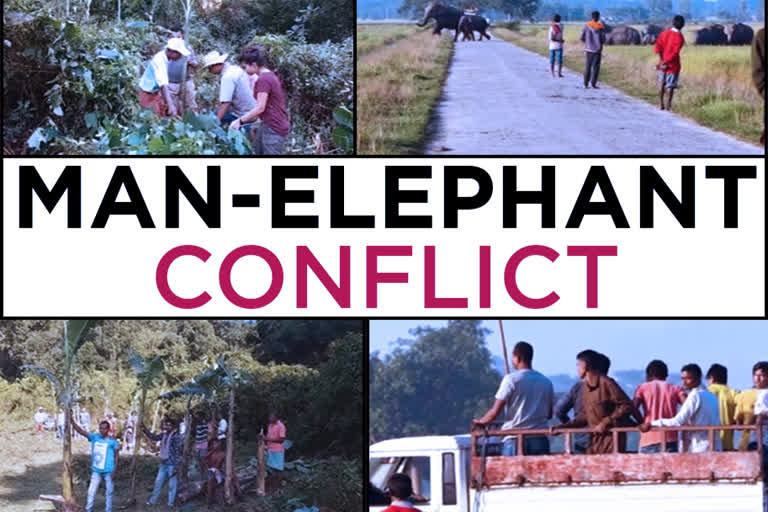Nagaon (Assam): The state of Assam has seen a spike in man-elephant conflicts since 2010, with the death toll amounting to 249 elephants and 761 humans.
The fight between elephants and men is due to the scarcity of food in the forest land of the state. Every year, the wild elephants come down the hills in search of food and water and destroy the paddy fields of the farmers of Assam's Nagaon district.
Located 110 km from the state's capital--Dispur, in Nagaon many wild elephants and people have died in the Man-Elephant conflict.
The herd of wild elephant ascending from Karbi Hillock to the plains of Nagaon has been severely damaging the paddy fields of the region.
According to sources, of the 249 elephant casualties, 92 died due to electrocution, 54 were mowed down by trains, 20 fell victim to poaching, 53 died in accidents and 30 were killed due to poisoning.
Previously, many measures were taken by villagers of Nagaon and nearby areas to mitigate man-elephant conflict, but nothing worked.
Aiming to reduce the Man-Elephant conflict, naturalist Binod Dulu Bora-- a local youth came up with the solution to avoid their crops being raided by elephants.
Bora along with the help of a cluster of villages donated 200 bighas (roughly 33 hectares) of community land to create a meal zone for elephants.
Even though the poor farmers did not have enough land to even feed their families, they still donated their land for elephants to get an adequate amount of food, the villagers grew paddy crops on the slope of Karbi Hillock for elephants.
Both naturalist Binod Bora and his wife are consistently working for the mitigation of Man-Elephant conflict.
Bora ensures that the food is available for the wild elephant in the hillock so that it does not need to come towards the plain.
He has been cropping the seeds of Rice, Napier grass and plants the tree of Banana and Sugarcane on the slope of the hillock.
Also Read: assam-drone-successfully-traces-elephant-which-killed-5-people-in-goalpara
The farmers and other nearest villagers of Samaguri and Berhampur have been largely relieved from such kinds of innovative initiatives.
The grass which is known as one of the most nutritional food items for the herbivorous animal has been cultivated upon 60 bighas (approx. 10 hectares) of land.
In the Hatihighuli region near Sapanala, the villagers are cultivating rice for the sake of the elephant's food.
In 2018, during winters, the regions like Hathighuli and Rangha had been badly affected when wild elephants attacked Karbi Hillock.
But, as of now, the scenario seemed to be normal than before. The consequences created by wild elephants become less in number, the forest department claims.
Naturalist Dulu Bora cultivates Rice in association with a wildlife conservation NGO "Hathi Bandhu" director, Pradip Bhuyan.
Pradip Bhuyan said, "The entire campaign of Rice cultivation upon 200 bighas land emerged successful because of the active cooperation of the villagers of Hathighuli Gaon, Rajen Choudhury, the divisional forest officer of Nagaon and district Agriculture department."
The naturalist Dulu Bora is also guided and accompanied by his wife Meghna Mayur Hazarika during his entire campaign.
Also Read: watch-wild-tusker-rescued-with-help-of-other-tamed-elephants



